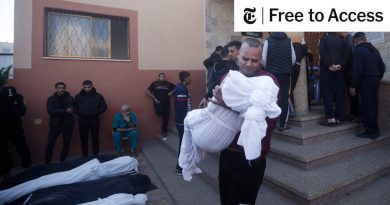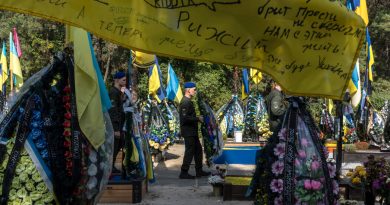Israel-Hamas War: Blinken Urges Israel to Protect Gaza’s Civilians if Truce Ends

As Israel and Hamas edged closer to the expiration of a fragile cease-fire, Secretary of State Antony J. Blinken met with Israeli leaders on Thursday and urged them to take concrete steps to reduce civilian deaths before it resumes an offensive against Hamas in Gaza.
With the cease-fire set to expire in a matter of hours, Mr. Blinken made clear that the U.S. does not oppose the resumption of Israel’s military offensive, despite international pressure for a permanent cease-fire. But he sought to shape the expected next phase of Israeli attacks on Hamas, hoping to limit civilian casualties, protect critical infrastructure like hospitals and power plants and ensure the flow of humanitarian aid into Gaza.
The steps Mr. Blinken outlined at a news conference in Tel Aviv after his meetings included designating safe areas for civilians to take refuge, protecting critical infrastructure and avoiding the long-term displacement of refugees within Gaza. “The way Israel defends itself matters,” Mr. Blinken said.
Israeli military officials insist that they are working to limit civilian casualties. But the first phase of their attack on Hamas drew international outrage after it killed more than 13,000 Palestinians, most of them women and children, according to Gazan health officials. Mr. Blinken said that he told Prime Minister Benjamin Netanyahu on Thursday: “Intent matters — but so does the result.”
The message was part of a delicate balancing act by the Biden administration, which faces pressure at home and abroad for its broad support of Israel’s military response to the Oct. 7 Hamas attacks. Biden officials have shifted to a strong emphasis on humanitarian concerns — while stopping short of pressing Mr. Netanyahu’s government to abandon plans for the destruction of Hamas, a goal that analysts say could take weeks or even months of bloody urban combat to achieve.
Mr. Netanyahu’s office said in a statement that it had two war aims: “Destroy Hamas and free the hostages. Israel is focused on accomplishing these missions.”
Mr. Blinken took care not to lay all the blame for civilian deaths on Israel, noting that Hamas uses human shields, mounts attacks from civilian infrastructure sites, and could “lay down its arms” and surrender its top leaders to end the fighting.
But his emphasis was on his Israeli hosts, over whom the U.S. has far more leverage than it does Hamas. He said that Israel should prepare for renewed fighting — which is expected to focus on southern Gaza, where top Hamas leaders are believed to be hunkered down — by “precisely designating areas” in southern and central Gaza for civilians to shelter from combat.
He also said Israel should allow civilians who fled from northern Gaza in the first weeks of the war to return home, adding, “There must be no enduring internal displacement.”
Mr. Blinken suggested that his call for protecting Palestinian civilians had reached receptive ears, at least in general terms. “The prime minister and members of the war cabinet agree with the need for this approach,” he said.
He did not cite any specific commitments by Israel, however. Nor did he explain how humanitarian aid might continue to reach Gaza if Israel’s military resumes its offensive, as Mr. Netanyahu has vowed it will. The truce is set to expire at 7 a.m. Friday morning local time.
And he also explicitly reaffirmed U.S. backing for Israel’s campaign against Hamas.
Mr. Blinken again said Israel had a right to ensure that Hamas was dismantled and could never again mount an attack like the Hamas-led massacres on Oct. 7, in which at least 1,200 people were killed, most of them civilians. Israel’s retaliatory air and ground war has killed more than 13,000 people, according to Gazan health officials.
“We will continue to support Israel’s efforts to do everything possible to ensure that Hamas does not repeat the horrors of Oct. 7,” he said. “How Israel does it, those are decisions for Israel.”
Mr. Blinken said the truce, which so far has lasted seven days, had made it possible to negotiate the release of scores of hostages and the shipment of new humanitarian aid into the enclave. He said negotiations to extend the cease-fire, involving Qatar and Egypt, were continuing. “Our immediate focus is working with our partners to extend the pause,” he said.
Mr. Blinken’s visit to Tel Aviv, Jerusalem and Ramallah in the West Bank came amid the release of additional hostages by Hamas and days of public pronouncements by the Israeli military and political leaders that a resumption of fighting was inevitable.
“We have sworn, I have sworn, to eliminate Hamas,” Mr. Netanyahu said after meeting with Mr. Blinken. “Nothing will stop us.”
Israeli officials have also said they are committed to freeing all of the roughly 240 people who they have said were abducted on Oct. 7.
Mr. Blinken’s visit was his fourth to Israel since the Oct. 7 attacks. In addition to Mr. Netanyahu, he met the Israeli opposition leader Yair Lapid and Defense Minister Yoav Gallant in Tel Aviv, and in Ramallah he met with Mahmoud Abbas, president of the Palestinian Authority. He was expected to travel on to Dubai for a climate conference and meetings with Arab leaders.
Ben Hubbard and Thomas Fuller contributed reporting.
Source – NY Times




